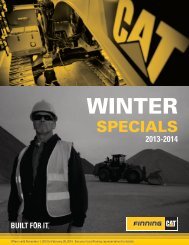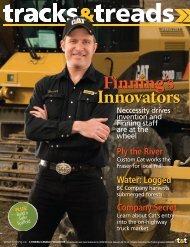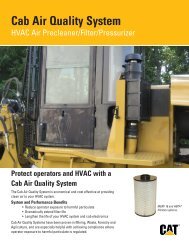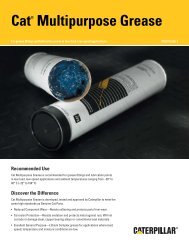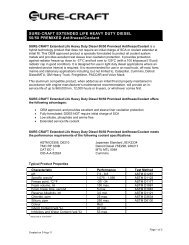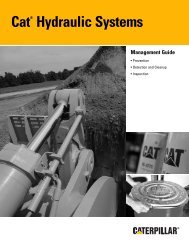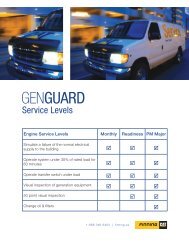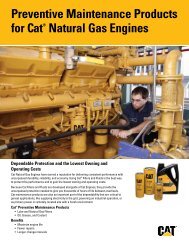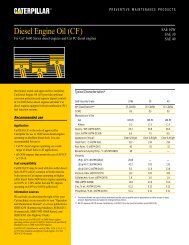How To Take A Good Oil Sample How To Take A Good Oil Sample ...
How To Take A Good Oil Sample How To Take A Good Oil Sample ...
How To Take A Good Oil Sample How To Take A Good Oil Sample ...
Create successful ePaper yourself
Turn your PDF publications into a flip-book with our unique Google optimized e-Paper software.
<strong>How</strong> <strong>To</strong> <strong>Take</strong> A <strong>Good</strong> <strong>Oil</strong> <strong>Sample</strong> <strong>How</strong> <strong>To</strong> <strong>Take</strong> A <strong>Good</strong> <strong>Oil</strong> <strong>Sample</strong> <strong>How</strong> <strong>To</strong> <strong>Take</strong> A <strong>Good</strong> <strong>Oil</strong> <strong>Sample</strong> <strong>How</strong> <strong>To</strong> <strong>Take</strong> A <strong>Good</strong> <strong>Oil</strong> <strong>Sample</strong><br />
The S•O•S SM program is one element of a condition monitoring<br />
philosophy that you can put into place with your equipment to monitor<br />
the impact of your maintenance program. The S•O•S program combined<br />
with regular inspections, analysis of your equipment’s site conditions,<br />
electronic data, and service history will enable you to evaluate your<br />
equipment’s health. You can perform a maintenance program on your<br />
own, or you can enlist the assistance of your Caterpillar Dealer to<br />
perform any level of preventive maintenance that will keep your<br />
equipment running at peak performance.<br />
Sampling Valve Method<br />
This sampling method requires a Brass Probe and approximately<br />
15 cm (6 in) of tubing. If you are sampling several compartments,<br />
begin with cleaner systems like hydraulics. Then sample the<br />
transmission or steering system. <strong>Sample</strong> engines and gear<br />
compartments last. Use a new piece of tubing for each sample.<br />
Re-using the tubing will contaminate other samples.<br />
The steps below outline the process of sampling engine oil. Use<br />
the same process for other pressurized compartments.<br />
Step A<br />
Before sampling, exercise the machine<br />
and implements to ensure the oil<br />
reaches operating temperature. This<br />
provides a S•O•S sample that is<br />
representative of the oil in the compartment.<br />
Set the engine at low idle.<br />
Remove the dust cap from the valve<br />
and wipe the valve with a clean cloth.<br />
Step B<br />
Insert the probe into the valve and<br />
collect about 100 ml (4 fl oz) of oil into<br />
a waste container. If the oil flow is<br />
slow at low idle, have someone accelerate<br />
the engine to high idle while<br />
extracting the sample. Dispose of the<br />
waste oil properly. This process<br />
cleans the valve.<br />
Step C<br />
Insert the probe into the valve again. Collect about 100 ml (4 fl oz)<br />
of oil or fill the sample bottle three-quarters full. Do not fill to the<br />
top. Do not allow any dirt to enter the bottle or bottle cap.<br />
Step D<br />
Withdraw the probe from the<br />
valve and secure the bottle cap.<br />
Place the bottle with the completed<br />
label into the shipping<br />
cylinder.<br />
<strong>To</strong> avoid contamination, do not<br />
take samples from the drain<br />
stream, a waste oil container, or<br />
a used filter.<br />
Fill out sample labels completely<br />
<strong>To</strong> receive the most value from S•O•S SM Services, supply all of<br />
the requested information. Model, serial number, and service<br />
meter units on both equipment and fluid are very important.<br />
Obtain fluid and maintenance information from shop records,<br />
Product Link, or EquipmentManager. Indicating fluid changes<br />
and top off fluid is also important. All of this information is<br />
critical to turn data into useful component health information<br />
and recommendations. Tip: fill out the sample label information<br />
before you begin taking samples to keep the label clean<br />
and easy to read.<br />
Vacuum Extraction Method<br />
This sampling method uses a Vacuum Extraction pump to sample<br />
non-pressurized systems. In general, use this method for geared<br />
compartments. It is important to use a new piece of tubing for<br />
each sample. Re-using tubing will contaminate other samples.<br />
It is recommended that pressurized systems without sampling<br />
ports be fitted with sampling port kits. For pressurized systems,<br />
this provides the most reliable sample. If a pressurized system<br />
does not have a sampling valve, follow the vacuum extraction<br />
method described below.<br />
The steps below outline the process of sampling a final drive.<br />
Use the same process for other non-pressurized compartments.<br />
Step A<br />
Before sampling, exercise the<br />
machine and implements to ensure<br />
the oil reaches operating temperature.<br />
This provides a S•O•S sample<br />
that is representative of the oil in<br />
the compartment. Turn the engine<br />
off. Measure and cut new tubing<br />
to the length of the dipstick. If the<br />
compartment you are sampling does<br />
not have a dipstick, cut the tubing so that it reaches about halfway<br />
into the fluid depth.<br />
Step B<br />
Insert the tubing through the head<br />
of the vacuum pump. Tighten<br />
the retaining nut. Tubing should<br />
extend about 4 cm (1 in) beyond<br />
the base of the vacuum pump<br />
head.<br />
Vacuum Extraction Method<br />
Step C<br />
Install a new sampling bottle onto<br />
the vacuum pump. Insert the end of<br />
the tubing into the fluid sump. Do<br />
not allow the tubing to touch the<br />
bottom of the compartment.<br />
Step D<br />
Pull the vacuum pump handle to<br />
create a vacuum. Hold the pump<br />
upright. If the pump is tilted or<br />
turned over, oil may contaminate<br />
the pump. If oil enters the pump,<br />
disassemble and clean it before<br />
taking the sample. Fill the sample<br />
bottle three-quarters full. Do not<br />
fill to the top. Do not allow any<br />
dirt to enter the bottle or bottle cap.<br />
Step E<br />
Withdraw the tubing from the compartment. Remove the bottle<br />
from the vacuum pump and secure the cap on the bottle.<br />
Then place the bottle with the completed label into the<br />
shipping cylinder.<br />
Step F<br />
<strong>To</strong> prevent contamination of the vacuum, loosen the nut and<br />
extend the tubing farther than 4cm (1in) past the base of the<br />
vacuum pump head. Extend the tubing far enough that tubing with<br />
no oil on the outside is showing. Use the tubing cutter to cut the<br />
tubing. The cut should be made where the outside of the tubing is<br />
oil free below the base of the vacuum pump head. The remaining<br />
tubing may be pulled through the pump without leaving any oil on<br />
the inside of the pump. Pulling the tubing through the top of the<br />
vacuum pump, without completing this step, will leave oil residue<br />
that will contaminate future samples.
Commitment of<br />
Service and Support<br />
<strong>How</strong> <strong>To</strong> <strong>Take</strong> A <strong>Good</strong> Coolant <strong>Sample</strong><br />
Sampling Valve Method<br />
Making S•O•S SM Sampling Easier<br />
®<br />
Cat Dealers define world-class product support.<br />
We offer you the right parts and service solutions, when and where<br />
you need them.<br />
The Cat ® Dealer network of highly trained experts keeps your<br />
equipment up and running to maximize your equipment investment.<br />
For more information, contact your local Cat Dealer<br />
or visit www.cat.com<br />
Coolant compartments with<br />
sampling valves can be<br />
sampled using the same steps<br />
as the oil sampling valve method<br />
described earlier.<br />
Vacuum Extraction Method<br />
If the cooling system is not equipped with sampling valves,<br />
coolant samples should be drawn from the radiator. While taking<br />
coolant samples from a radiator, please observe safety precautions.<br />
The sample should be taken after the coolant has been well<br />
circulated. <strong>How</strong>ever, do not remove the radiator cap if the coolant<br />
is hot. The best time to take samples is after the engine has been<br />
shut down for an hour or two after a normal workday.<br />
Carefully remove the radiator cap to take the sample. Use<br />
the same steps as the vacuum extraction oil sample method<br />
described earlier.<br />
Caution, samples drawn from the overflow tank or the system<br />
drain valve will not be representative of the fluid in the<br />
cooling system.<br />
Always use a separate vacuum extraction pump for coolant<br />
samples. Although the fluid does not enter the barrel of the<br />
pump, samples may indicate compartment contamination. Vacuum<br />
pumps that contain residue from coolant samples may indicate<br />
coolant contamination in oil samples. Vacuum pumps that<br />
contain oil residue may indicate oil entry into the cooling system.<br />
Designate a separate pump for coolant samples.<br />
Install Sampling Valves<br />
Most current Cat ® engines and machine<br />
models are equipped with sample valves<br />
for pressurized compartments. Valves<br />
may be easily and inexpensively added if<br />
needed. It is important to install valves<br />
in the correct location in each system.<br />
Avoid contaminating the system during<br />
installation. We can help you with<br />
specific installation procedures.<br />
Use A Tube Cutting Device<br />
Cutting tubing with a pocketknife is difficult. Particles from the<br />
knife can contaminate the tubing and the S•O•S SM sample.<br />
<strong>To</strong> avoid these problems, use a Tube Cutter. A quick, clean cut<br />
can be obtained using just one hand.<br />
Keep Sampling Supplies Clean<br />
Store bottles and tubing<br />
in dust free plastic bags.<br />
Keep new, empty bottles<br />
capped. The vacuum<br />
pump and brass valve<br />
probe should also be<br />
protected from dust. If a<br />
sample becomes contaminated<br />
during sampling, it<br />
should be discarded. <strong>Take</strong><br />
a new sample that is not contaminated.<br />
<strong>How</strong> <strong>To</strong> <strong>Take</strong> A<br />
<strong>Good</strong> S•O•S SM <strong>Sample</strong><br />
Cat S•O•S SM Services<br />
PEGJ0047-01 © 2012 Caterpillar All Rights Reserved Printed in U.S.A.<br />
CAT, CATERPILLAR, their respective logos, “Caterpillar Yellow” and the POWER EDGE trade dress, as<br />
well as corporate and product identity used herein, are trademarks of Caterpillar and may not be used<br />
without permission.



